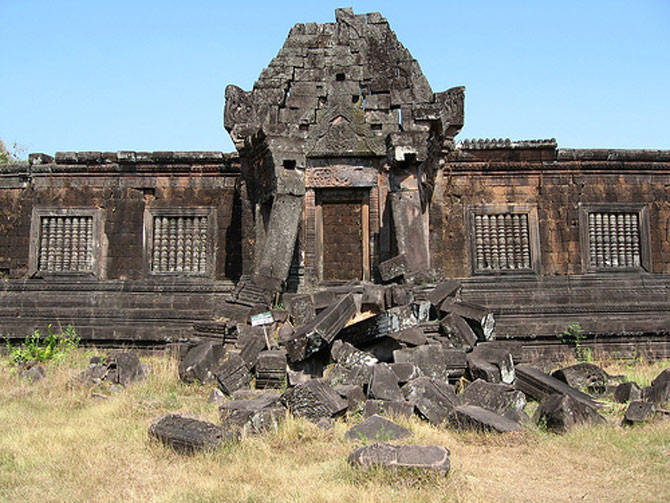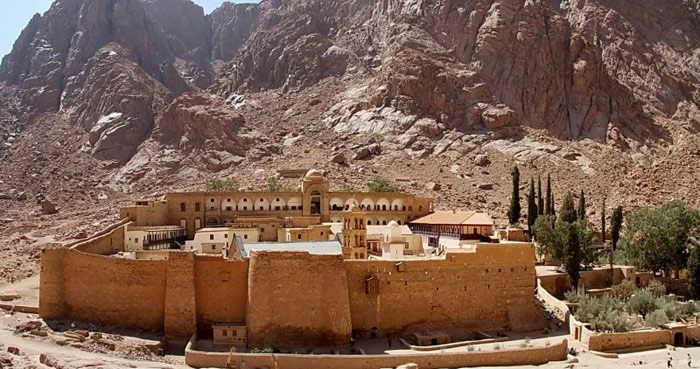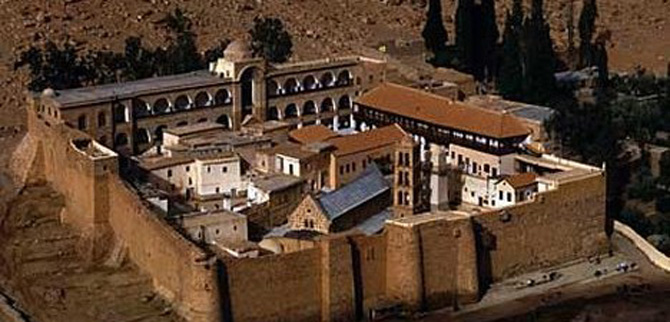Monastery of Saint Catherine
Unesco's Scientific, Educational and Cultural Organization has recognized the Monastery of Saint Catherine of Egypt as a World Cultural Heritage in 1979.

Saint Catherine's monastery was built at the foot of Moses mountain, also known as Mount Sinai, between 527 and 565 under the reign of Emperor Justinian . The monastery of Saint Catherine, truly the place to perform priceless works of art from the 6th century, Arab mosaics, symbols of Greece and Russia has also been brought here. To the west of the monastery are oil paintings painted on wax. This monastery is also decorated with marble, enamel paintings. But the true significance of this monastery is the possession of a collection of handwritten Bible manuscripts . The number of invaluable manuscripts in the monastery is just behind the Vatican.

The location of the monastery of Saint Catherine is said to be the place where the prophet Moses saw God. After seeing God, the prophet Moses led the Jews to this mountain but here he alone went up to the mountain to meet Jehovah and was given the Ten Commandments .
 Panoramic view of monastery of Saint Catherine with typical Byzantine architecture.The present monastery is still quite intact as the oldest remaining monastic work
Panoramic view of monastery of Saint Catherine with typical Byzantine architecture.The present monastery is still quite intact as the oldest remaining monastic work
In fact, Saint Catherine Monastery was built to serve as a place to commemorate the martyr of Catherine . Legend has it that a monk found Catherine's body at the highest peak of Mount Sinai (which was later named Catherine's peak).
Not only is a valuable architecture with the characteristic Byzantine architecture that Saint Catherine Monastery is truly an invaluable art museum . The decorations, displayed here are from the 6th century brought from Arab, Greek and Russian.

To the west of the monastery are oil paintings painted on wax. Besides wax paintings, Saint Catherine's monastery is also decorated with marble, enamel paintings. Another extremely precious artifact that was kept at the monastery was the cup containing the relic . This glass was given to the monastery by Tsar Alexander II in the 19th century.

Although there are countless precious artifacts, paintings and sculptures, the monastery's greatest value lies in the manuscript collection. Manuscripts of the scripture written at the 3,500-something monastery are written in Greek, Egyptian, Armeni, Jewish, Slavic and ancient Xyri . Egyptians believe that a German graduate student visited the library in 1844 and stole a Bible manuscript, which is now on display at a British museum in London. According to many documents, the Monastery of Saint Catherine also has a mosque called Fatimid , built at least 10 or 11 centuries ago. This church was built to show concessions to Muslims at that time. There is also another small chapel (St. Triphone chapel, known as the Skull House), the skull of the monks who lived and died here.

Another special thing is that this place is considered to be the oldest ever-existing monastery of Christians, even though Anthony's monastery is considered to be an early monastery and is the smallest diocese. world. This monastery was previously ordered by Queen Helen , the mother of the great Constantine, but it was built under Emperor Justinian, where Catherine's remains are located. Catherine's body is believed to have been carried away by angels but was discovered 500 years later on the top of a hill that later bears the holy name. Traces of St. Catherine are kept in a marble relic place at the main cathedral.

Surviving for 15 centuries, Saint Catherine Monastery has remained relatively well preserved. Is an invaluable art museum from the 6th century not only of Egypt but also of the world.
- Monastery of Saint - Gall (Switzerland)
- Monastery of Citeaux in Fontenay (France)
- Haghpat Monastery
- Braided hair may belong to the goddess in the coffin
- Tushilumpo Monastery - A marvelous architecture of Tibet
- Du spring Truc Lam Tay Thien Monastery
- For the first time St. Valentine portrait was revealed
- Geghard Monastery and Azat Valley
- Sanahin Monastery - World Cultural Heritage in Armenia
- Owned oyster Saint-Jacques 'special telescope'
- Studenica Monastery - Yugoslavia
- Fontenay Monastery - France
 Suzhou classic bonsai garden - China
Suzhou classic bonsai garden - China Chau Nguyen Dynasty
Chau Nguyen Dynasty Thai Son Mountain - World Wonder
Thai Son Mountain - World Wonder Ancient villages of Shirakawa-go and Gokayama
Ancient villages of Shirakawa-go and Gokayama